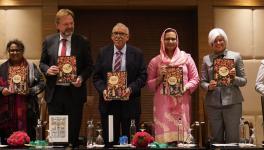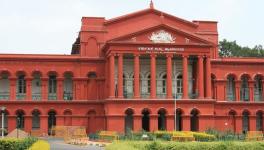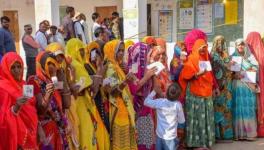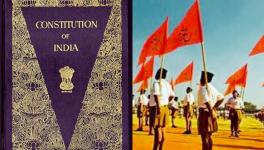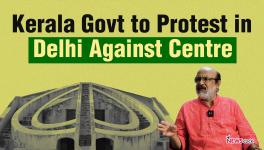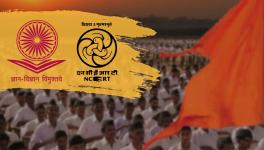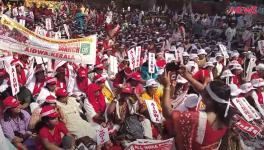Bhim Yatra .. So That There are No More Killings
Rarely does Jantar-Mantar, the place in the heart of Delhi, gets ‘enlivened’ with people who share very similar type of tragedy - one should say man made tragedy. The culmination of 125 day Bhim Yatra - led by Safai Karmchari Aandolan - which had started from Dibrugarh in the North East on 10 th December and had traversed around 500 districts and 30 states, proved to be one such occasion. (13 th April 2016)
The big public meeting organised at Jantar Mantar, attended by hundreds of safai karmcharis from different parts of the country and many individuals, activists who are sympathetic to their cause, was just another way to celebrate Dr Ambedkar’s 125 th birth anniversary, a day earlier. Special focus of the Yatra was on deaths in sewers and septic tanks and the key slogan was ‘Stop Killing us in Dry Latrines, Sewers and Septic tanks’. In fact, most of the people who were sitting on the podium belonged to such families only, who had lost their near-dear ones in cleaning sewer or septic tanks
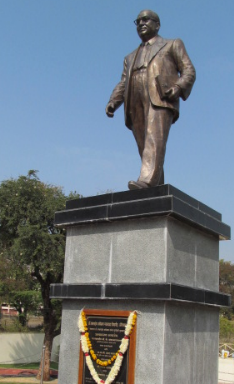
Image Courtesy: wikipedia.org
Sunayana ( age 9 years) who lives with her grandparents these days in Lucknow, had lost her father in similar ‘accident’ and her mother also died due to shock within few days of her father’s death. There was Rahul ( aged 13 years) from Tamil Nadu who had lost his father merely a week back and was inconsolable on stage also. Pinki ( aged 35 year) from Varanasi, a mother of two kids was one of the most articulate among those who had gathered there. She had lost her husband three years back and was emphatic that ‘we are not here for compensation.’ We are part of this caravan now and ‘want that nobody should face similar tragedies hereafter.’ Kartar ( Delhi) still could recount how his son was called by his contractor when a fellow worker had already died cleaning the sewer. According to him the contractor rather forced him to descend into the sewer and take out fellow workers body and in the process his son also inhaled poisonous gases and died on the spot.
Everybody had a heartrending story to tell. Many like Santosh just could not even utter a word as it was no narrating an experience but ‘reliving’ the whole episode and its aftermath.
A query rather resonated all these presentations: How long their sons/husbands will have to die cleaning other people’s waste and excreta in a country which boasts of sending satellites into space. How does one explain allotment of thousands of crores of Rs for drainage and sewerage work, so much money being spent on laying/relaying pipes and drains that are designed to kill? Is it because ours is a society where Varna mind-set still dominates, and that’s why a human friendly system of garbage and sewage management has still not been conceived as planners rely on ‘expendable dalit labour’.
Charter of Demands - Bhim Yatra : Stop KILLING us
To tender an apology to the safai karamchari community for the historical injustice and centuries of humiliation heaped on us by engaging us as manual scavengers,
To eliminate manual scavenging immediately, without any further delay or postponement. We will not accept any more deadlines that were extended in the past, from time to time
Stop the deaths in sewer lines and septic tanks at all costs. Modernize and mechanize the sanitation system and do whatever it takes to stop killing people in sewer work
Pay Rs. 10 lakhs as mandated by the SC order, to dependants of those who have died in sewer lines since 1993 without any hassles or hesitation
Enhance the one time cash payment given as immediate relief to liberated manual scavengers from Rs. 40,000 to Rs. Three lakhs.
Interestingly it was only last month that a member of Parliament from Upper House during zero hour session said that there ‘ there are more than 22,000 deaths every year while cleaning sewers in different parts of the country ‘as per the records of National Commission of Safai Karmacharis’(34. http://www.thehindubusinessline.com/news/high-death-rate-among-scavengers-while-on-duty-bjp-mp/article8331909.ece) One does not know how the NCSK has got these figures but it is interesting to note that the figures quoted by the honourable member of the ruling party exactly matched the details of a story in a magazine which had appeared nine years back. The said story titled “Life Inside a Black Hole,” discussed how “Beneath the glitter of India are dark alleys in which are trapped poisonous gases and millions of Dalits who do our dirty job in return for disease and untouchability.” According to the author Siriyan Anand,
At least 22,327 Dalits of a sub-community die doing sanitation work every year. Safai Kamgar Vikas Sangh, a body representing sanitation workers of the Brihanmumbai Municipal Corporation (BMC), sought data under the Right to Information Act in 2006, and found that 288 workers had died in 2004–05, 316 in 2003–04, and 320 in 2002– 03, in just 14 of the 24 wards of the BMC. About 25 deaths every month. These fi gures do not include civic hospital workers, gutter cleaners or sanitation workers on contract. Compare this with the 5,100 soldiers—army, police, paramilitaries—who have died between 1990 and 2007 combating militancy in Jammu and Kashmir (Anand, Siriyavan (2007) : "Life Inside a Black Hole," Tehelka, Vol 4, No 44, http://archive.tehelka.com/story_main36.asp?filename=Neo81207LIFE_INSIDE.asp,accessed on 18 Feb 2015).
Not that there have not been legislative actions or policy interventions to stop these killings but the impact has been symbolic. It was the year 2014 when Supreme Court passed a historic judgement and also asked the all the State Governments and the Union Territories to fully implement the 2013 act, prevent deaths in sewer holes and grant compensation of Rs 10 lakh to families of all persons who have died in manholes. A study by Safai Karmchari Aandolan reveals that only in 3 % cases families of victims received the promised compensation.
So many avoidable deaths cleaning sewers/septic tanks here can create an impression that deaths in sewers is a common phenomenon everywhere? Definitely not. An occupational health physician Ashish Mittal’s study on Sewer Workers ( Hole to Hell, 2005) had in fact compared situation here with situation in most developed nations? It explained
‘[m]anhole workers there are protected in bunny suits to avoid contact with contaminated water and sport a respiratory apparatus; the sewers are well-lit, mechanically aerated with huge fans and therefore are not so oxygen deficient. In Hong Kong, a sewer worker, after adequate training, needs at least 15 licences and permits to enter a manhole.’
Addressing the gathering at Jantar Mantar, Bejwada Wilson, who is a leading activist of the ‘Safai Karmachari Aandolan’ narrated an experience from Ahmedabad leg of this tour. During meeting in one of the bastis of safai karamcharis he met a young boy who told him that he wants to become a doctor. When the boy was prodded further, it was discovered that his father had died because of poisonous gases inside the sewer, and could have been saved had he received medical attention in time. The boy was emphatic ‘ If I become a doctor, then I can at least ensure that such people can receive immediate medical treatment’.
It is very positive sign that there are voices of fresh rumblings within the historically despised and stigmatised 'scavenging' communities and a large section of the younger ones of the community are getting ready to come out of broom and human waste.
To conclude, the Bhim Yatra with the key slogan of ‘Stop Killing Us in Dry Latrines, Sewers and Septic Tanks’ has come at a very inopportune time as far as the trumpetting which is being witnessed around Swacch Bharat Abhiyan.
One learns that the government wants to send across a very positive image of its flagship programme. Apart from directing different governments to retake the pledge which was administered to them at the launch of the campaign and imposing a Swacch Bharat cess of 0.5 % on all services liable for service tax, a proposal is also under consideration wherein the private companies and PSUs would be asked to spend around 30 % of CSR funds on this initiative.
But as it is evident all the glitter and glow would not be able to hide the penetrating questions being raised or the devastating criticism it is being subjected to. All the claims of Swacch Bharat Abhiyan notwithstanding , it will have to answer the simple query raised by Bhim Yatra that manual scavengers are still being 'killed' in dry latrines, sewers and septic tanks and for them how fictitious all these promises of 'Clean India' look.
Peoples Media Advocacy & Resource Centre- PMARC has been initiated with the support from group of senior journalists, social activists, academics and intellectuals from Dalit and civil society to advocate and facilitate Dalits issues in the mainstream media. To create proper & adequate space with the Dalit perspective in the mainstream media national/ International on Dalit issues is primary objective of the PMARC.
Disclaimer: The views expressed here are the author's personal views, and do not necessarily represent the views of Newsclick
Get the latest reports & analysis with people's perspective on Protests, movements & deep analytical videos, discussions of the current affairs in your Telegram app. Subscribe to NewsClick's Telegram channel & get Real-Time updates on stories, as they get published on our website.









